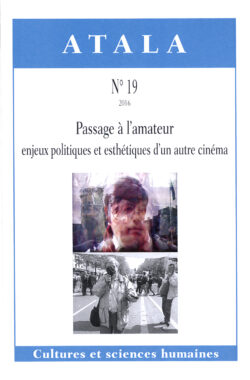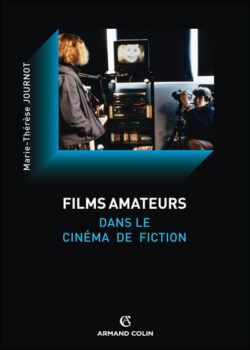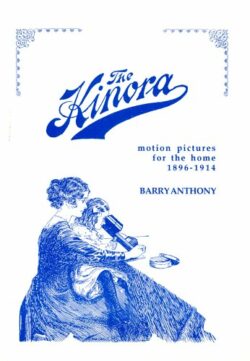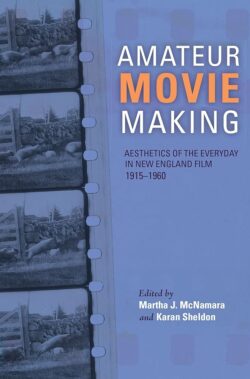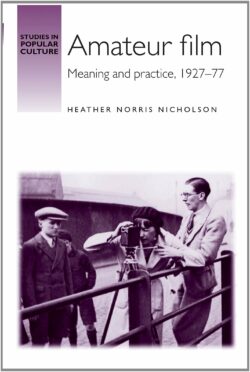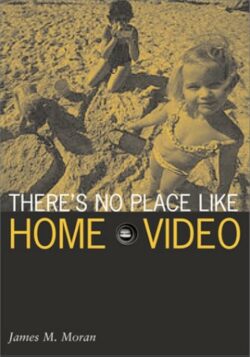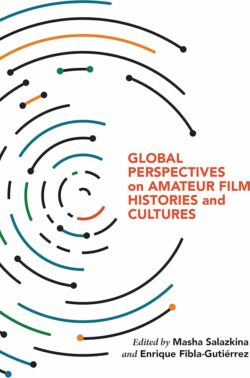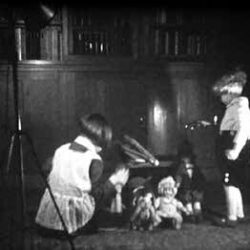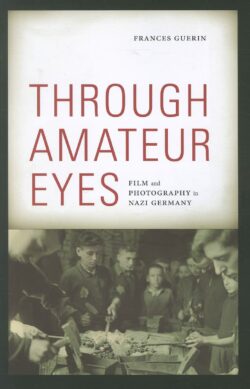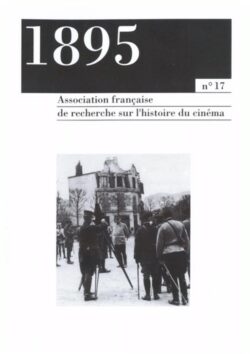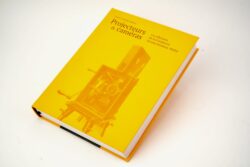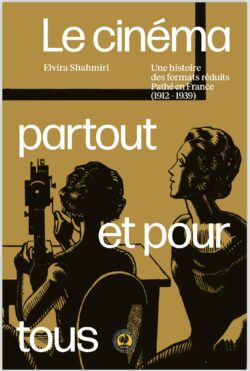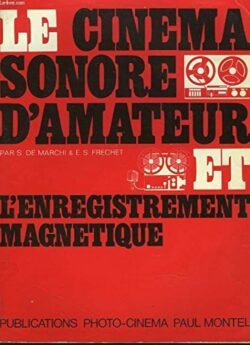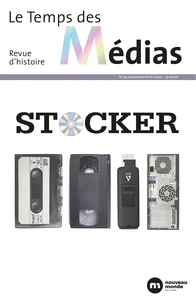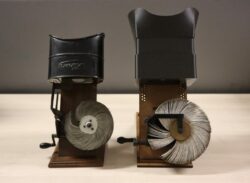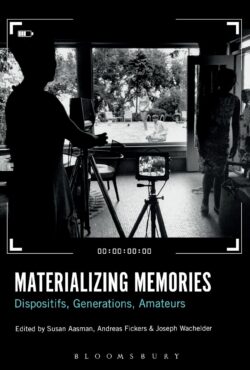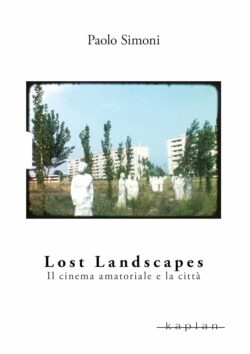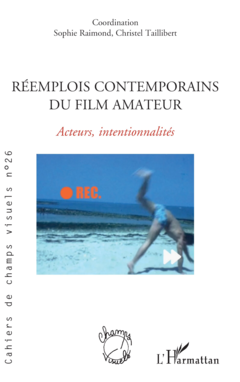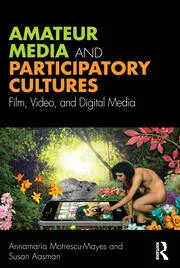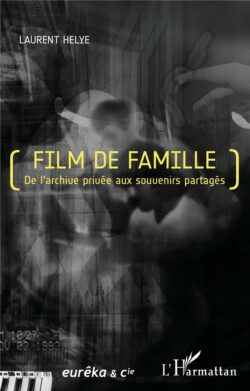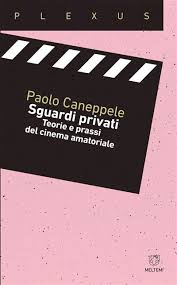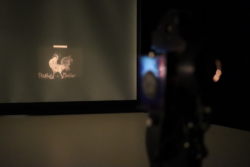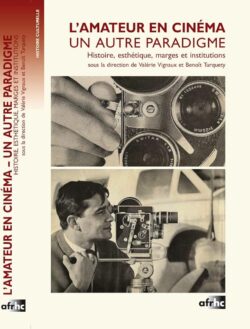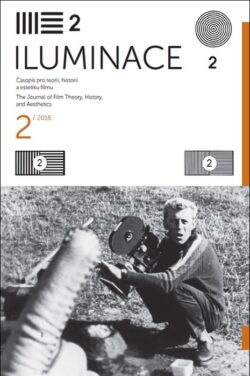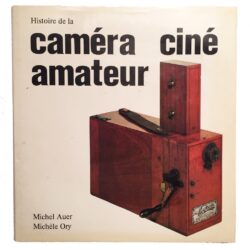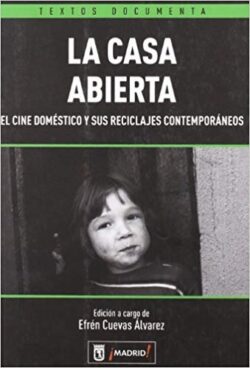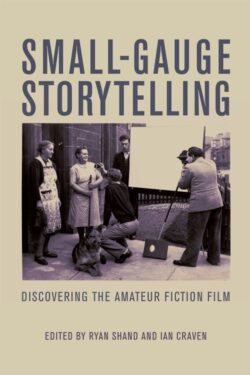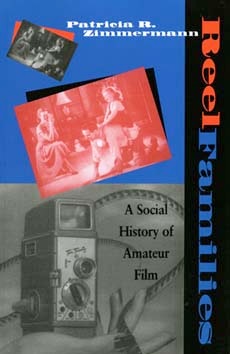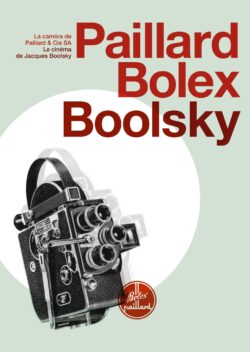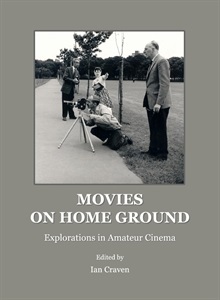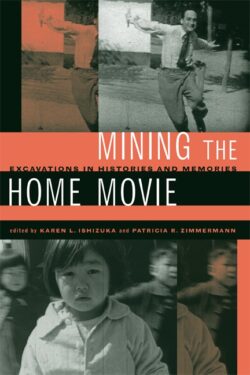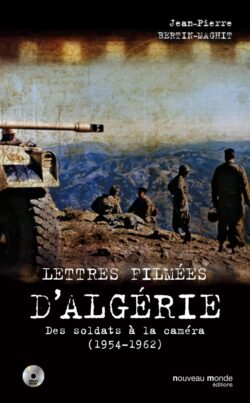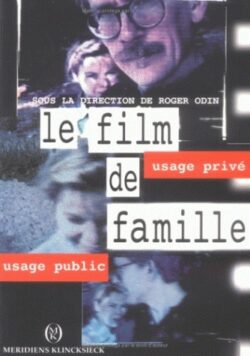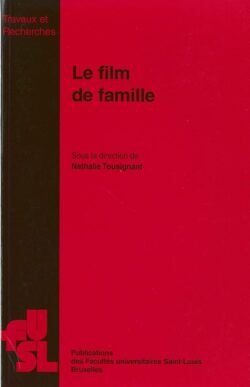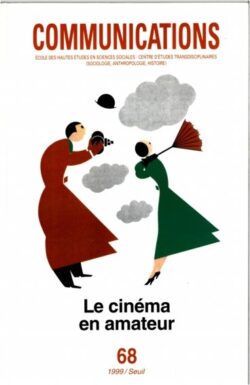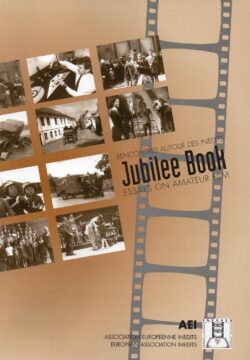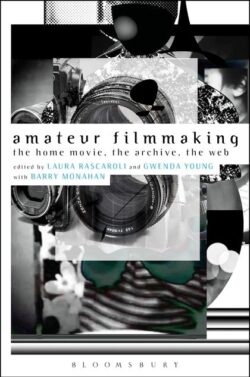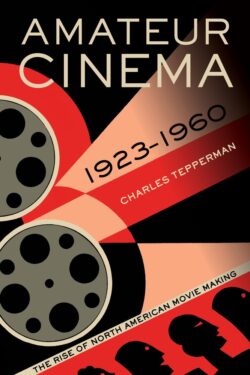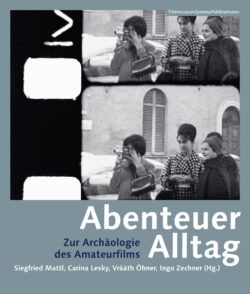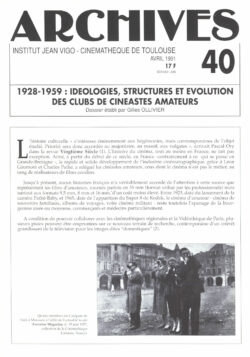- A
- B
- C
- D
- E
- F
- G
- H
- I
- J
- K
- L
- M
- N
- O
- P
- Q
- R
- S
- T
- U
- V
- W
- X
- Y
- Z
- ArticleArticle
Time Travel with Pathé Baby: The Small-Gauge Film Collection as Historical Archive
Alexandra Schneider, Film History: An International Journal 19 (4), 2007, 353-360, English,More informationsEven before Pathé launched its 9.5mm ‘Pathé Baby’ films in 1923 and Eastman Kodak its 16mm ‘cinegraphs’ in 1927, collectors were purchasing and acquiring small-gauge film prints to project in their homes. Focusing on European collectors of the 1930s, this essay argues that historians must consider the private film collection’s status as an archive and a source for film historiography. Individuals and families viewed reduction prints of theatrical motion pictures in ‘living room cinemas’, programmed alongside the original amateur productions called ‘home movies’. Surviving private film collections bear traces of nontheatrical viewing practices, which remains a gap in the knowledge of film history.
Themes : Matériel | Travaux universitaires | Histoire | Archive et cinémathèques - Book
The Structures of the Film Experience
Jean-Pierre Meunier, Louvain, Amsterdam University Press, 1969, 142, French,More informationsJean-Pierre Meunier’s Les structures de l’experience filmique: L’identification filmique from 1969 is a key text in the history of film studies. Drawing on the work of the French pioneers of phenomenology, Maurice Merleau-Ponty and Jean-Paul Sartre, as well as on the insights of the French Filmology movement, Meunier distinguishes between three major types of engagements viewers can have with moving images: the fiction attitude, documentary attitude and home movie attitude. With this seemingly innocuous distinction, Meunier opens up a new field of inquiry. By adding the home movie attitude as the third type of engagement, he integrates a large and long-neglected type of cinematic practice into the field of film studies and film theory, namely the non-theatrical non-fiction film. Meunier’s pioneering gesture continues to reverberate throughout film studies, where non-theatrical film has become one of the main areas of research over the last decade. (Julian Hanich & Vinzenz Hediger)
Themes : Matériel | Film de famille - ArticleArticle
Home Movies as Reliquaries of Memory: A Phenomenological Perspective
Lourdes Esqueda Verano, Film Philosophy 28 (2), 2024, 350-374, English,More informationsIf film immortalises the ephemeral and presentifies the past, this is especially true of home movies, whose content is not the result of a narrative composition or an invention of fiction, but the product of fragments of reality. These three categories – fiction, documentary, and the home movie – have been analysed by Jean-Pierre Meunier and Vivian Sobchack, with an emphasis on the effect that each film mode can have on the spectator, eliciting a particular emotional and cognitive response. But these authors’ models depend entirely on the spectator’s experience to identify each mode, with the home movie being limited to footage in which we can recognise our own families. Nevertheless, a stranger’s home movie can elicit an act of recognition through an intersubjectivity that arises from the footage.
Themes : Travaux universitaires | Film de famille - Revue
Atala. Cultures et sciences humaines no. 19 : Passage à l'amateur. Enjeux politiques et esthétiques d'un autre cinéma
Collective, 2016, 349, French,More informationsThe journal Atala has chosen to focus on what might be called “alternative” cinema, a type of cinema that is less well known because it is less constrained by the norms of international or national film production. Approaching cinema through the lens of amateur filmmaking is not new, but it seemed important to re-examine the issues surrounding amateur cinema today, at a time when opportunities for creation and distribution are proliferating and becoming universal, increasingly blurring the lines between professional and amateur/non-professional cinema despite the persistent differences in production and financing between the two.
The originality of this issue lies in the proposal made to the authors to use the more specific notion of the transition to amateurism as a tool for reflection and analysis. This concept makes it possible to simultaneously describe the subversive emergence of new forms of cinema in the global political arena in the second half of the 20th century and the individual approach of filmmakers who claim amateur cinema as their preferred form of expression without renouncing their professional identity. The transition between amateurism and professionalism blurs the lines between categories, often revealing the implementation of an “amateur approach” or “amateur values” that also allow us to understand certain actors’ interpretative style or certain directors’ aesthetics. These amateurs of a different kind share a search for authenticity and the belief that the imperfections and flaws of reality act as proof of the truth of images, a belief that each author in this issue ardently questions.
The book is divided into three parts: Insights: The love of the amateur; Perspectives: the amateur internationale; Experiences: the work of the amateur.
***
Copyright for the cover : frames © Gérard Courant
Themes : Travaux universitaires | Histoire | Film de famille | Clubs de cinéastes - Book
Films amateurs dans le cinéma de fiction
Marie-Thérèse Journot, Paris, Armand Colin, 2011, 192, French,More informationsHoneymoons, marital crises, children leaving home: as in real life, fictional characters film their loved ones, confide in their cameras and, above all, look at images from the past. Today’s cinema is full of references to amateur practices made commonplace by technological developments: home movie, filmed diary, reportage, surveillance footage and snuff film are all made using Super-8 or video, webcams or pocket films.
This book takes stock of this all-too-often invisible process, whose reflexivity makes it a revealing motif that can disclose a secret meaning and create a signature effect. The book is based on numerous analyses of sequences and films, some of them very well-known – Rebecca, Peeping Tom, Paris, Texas, Caché – and others that have become cult films thanks to the use of this aesthetic matrix, both in mainstream cinema – The Blair Witch Project or Cloverfield, for example – and in autofiction, with Pardonnez-moi or Tarnation.Themes : Film de famille | Réappropriation créative - BookBook
Amateurfilm in Osterreich: An Beispielen des Personlichen Gebrauchs
Franz Schlager, Vienna, VWGO, 1992, 428, German,More informationsThis 428-page book publishes the research done for a doctoral dissertation at the University of Salzburg. Part I presents research on the history of amateur film production in Austria. Part II consists of transcriptions of interviews with six Austrian amateur filmmakers. A thirty-page bibliography is also included. Schlager later co-authored a historical study of the ergonomics of amateur film equipment, From Dobler to DV-CAM (2000).
Themes : Matériel | Travaux universitaires | Histoire | Film de famille | Clubs de cinéastes - BookBook
Amateur movie making (cameras & accessories): a lexicon of basic terms with definitions and synonyms
Ray J. Pollet, Montreal, Leméac, 1970, 127, French, English,More informationsThemes : Matériel | Film de famille | Clubs de cinéastes - Book
The Kinora: Motion Pictures for the Home 1896-1914
Barry Anthony, London, The Projection Box, 1996, 40, English,More informationsA history of the system, and a newly-compiled illustrated catalogue of Kinora reels.
Themes : Matériel | Histoire - Contenu Web
Archipop - Le Magazine
Collective, French,More informationshttps://archipop.org/lemagazine/
Themes : Histoire | Archive et cinémathèques | Film de famille | Clubs de cinéastes | Réappropriation créative | Valorisation - Book
Amateur Movie Making: Aesthetics of the Everyday in New England Film, 1915–1960
Martha J. McNamara, Karan Sheldon, Indiana University Press, 2017, 304, English,More informationsA compelling regional and historical study that transforms our understanding of film history, Amateur Movie Making: Aesthetics of the Everyday in New England Film, 1915–1960 demonstrates how amateur films and home movies stand as testaments to the creative lives of ordinary people, enriching our experience of art and the everyday. Here we encounter the lyrical and visually expressive qualities of films produced in New England between 1915 and 1960 and held in the collections of Northeast Historic Film, a moving image repository and study center that was established to collect, preserve, and interpret the audiovisual record of northern New England. Contributors from diverse backgrounds examine the visual aesthetics of these films while placing them in their social, political, and historical contexts. Each discussion is enhanced by technical notes and the analyses are also juxtaposed with personal reflections by artists who have close connections to particular amateur filmmakers. These reflections reanimate the original private contexts of the home movies before they were recast as objects of study and artifacts of public history.
Themes : Travaux universitaires | Histoire | Archive et cinémathèques | Film de famille - Book
Amateur Film: Meaning and Practice, 1927-77
Heather Norris Nicholson, Manchester University Press, 2012, 296, English,More informationsAmateur film: Meaning and practice 1927–77 plunges readers into the world of home movies making and reveals that behind popular perceptions of clichéd family scenes shakily shot at home or by the sea, there is much more to discover. Exploring who, how, where, when and why amateur enthusiasts made and shared their films provides fascinating insights into an often misunderstood aspect of national visual history. This study of how non-professional filmmakers responded to the new possibilities of moving image places decades of cine use into a history of changing visual technologies that span from Edwardian visual toys to mobile phones. Using northern cine club records, interviews and amateur films, the author reveals how film-making practices ranged from family footage to highly crafted edited productions about local life and distant places made by enthusiasts who sought to ‘educate, inspire and entertain’ armchair audiences during the early decades of British television.
Themes : Histoire | Film de famille | Clubs de cinéastes - Book
There's No Place Like Home Video
James Moran, University Of Minnesota Press, 2002, 256, English,More informationsFrom its recording of family events to its influence on filmmaking, home video defies easy categorization and demands serious consideration. In There’s No Place Like Home Video, James Moran takes on this neglected aspect of popular culture. He offers a cultural history of amateur home video, exploring its technological and ideological predecessors, the development of event videography, and its symbiotic relationship with television and film. He also investigates the broader field of video, taking on the question of medium specificity: the attempt to define its unique identity, to capture what constitutes its pure practice.
In Moran’s discussion of video, he argues that previous scholars have not sufficiently dealt with its nature as hybrid, varied, and mutable. He argues that such a medium shouldn’t be conceived as pure in and of itself; it is neither autonomous from other media nor entirely dependent on any other, but instead has a chameleonlike interface with films, television, computers, telephones, and even architecture. Rather than look for a grand narrative to define its specificity, Moran places video and home video at the intersections of multiple forms of communication.
Themes : Travaux universitaires | Histoire | Film de famille - Book
Global Perspectives on Amateur Film Histories and Cultures
Masha Salazkina, Enrique Fibla-Guttiérez, Indiana University Press, 2020, 348, English,More informationsThemes : Travaux universitaires | Histoire | Film de famille | Clubs de cinéastes - ArticleArticle
Men with the Movie Camera between 1945 and 1989. Domesticating Moving Image Technology under Communism
Melinda Blos-Jáni, Martor Nr. 18, 2013, p. 77-92, English,More informationsThe fascination of filmmakers with children is constant ever since the first home movies from the 1900’s to the user generated videos of the new media age. This study unfolds the amateur filmmaking practices of a family’s two generations while, in fact, inquiring into how the filmmaking technologies of a given period (1945-1989) were built into a community’s living space (both in a physical and metaphorical sense) and how they structured it. Through the history of the Haáz family living in Târgu-Mureş and the history of the local Film Club (and its leader, Ervin Schnedarek), we can explore the periods in the symbiosis of moving image and everyday life, the changing domestication process of the medium of film, and the shifting visual construction of childhood. In the meantime attention will be paid to the impact of state regulation of amateur film collectives and equipment, on the fact that these domestication stories occurred in the socialist Romania. The starting point of this analysis is that private films are not only embedded in the life of the individual, but also in the time of everyday life, in the history of representational forms and in macro contexts.
Themes : Travaux universitaires | Histoire | Film de famille | Clubs de cinéastes - Article
Children Addressing the Camera. Performing Childhood in Transylvanian Home Movies from the 1930s
Melinda Blos-Jáni, Martor Nr. 20, 2015, p. 109-121, English,More informationsEver since the emergence of the first technologies destined for amateur filmmakers, the most frequently recorded portraits in home movies have been children’s. This article analyses the characteristics of children’s portraiture in home movies, with special attention to their on-camera performance. Home movies can be seen as records of children’s bodily interaction with the filmic apparatus and, at the same time, with the media literacy of their filmmaker-parents. he everyday scenes of children performing awareness or non-awareness in front of the camera are dissected in this paper from a media-historical point of view: the analysis of a Transylvanian home movie collection is embedded in a discourse on media practices, on mediality and on processes that transform everyday reality into a corporeal image. The idiosyncrasies of the first Transylvanian home movies are incorporated in a discussion about early 20th century visual culture, in the context of which childhood gets to be constructed as an amateur moving image.
Themes : Travaux universitaires | Histoire | Film de famille - Book
Through amateur eyes: film and photography in Nazi Germany
Frances Guerin, University Of Minnesota Press, 2012, 352, English,More informationsWe have seen the films of professionals and propagandists celebrate Adolf Hitler, his SS henchmen, and the Nazi Party. But what of the documentary films and photographs of amateurs, soldiers, and others involved in the war effort who were simply going about their lives amid death and destruction? And what of the films and photographs that want us to believe there was no death and destruction? This book asks how such images have shaped our memories and our memorialization of World War II and the Holocaust. Frances Guerin considers the implications of amateur films and photographs taken by soldiers, bystanders, resistance workers, and others in Nazi Germany.
Her book explores how photographs taken by soldiers and bystanders on the Eastern Front, depictions of everyday life in the Lódz ghetto, and home movies and family albums of Hitler’s mistress Eva Braun, among others, can challenge the conventional idea that such images reflect Nazi ideology because they are taken by perpetrators and sympathizers. Through Amateur Eyes upsets our expectations and demonstrates how these images can be understood as chillingly unrehearsed images of war, trauma, and loss.
Themes : Histoire | Film de famille - ArticleArticle
The Sound of Amateur Film
Liz Czach, Film History, Vol. 30, n. 3, 2018, p. 75-102, English,More informationsThis essay examines why amateur filmmakers did not adopt sound despite the apparent desire for it mentioned in the pages of Movie Makers and other forums. The failure of the RCA-Victor camera provides a focal point from which to examine the history of amateur film sound and how this short-lived camera mirrors and anticipates many of the problems that would unceasingly thwart attempts to bring sound to amateur film practice. To begin recovering the history of amateur sound production, I concentrate on how one amateur filmmaker, Archie Stewart, eagerly took up sound filmmaking (with the RCA-Victor camera) only to abandon it a few short years later. Stewart’s amateur sound films of the 1930s are illustrative of the kinds of frustrations and limitations a keen and committed amateur filmmaker encountered.
Themes : Matériel | Travaux universitaires | Histoire - Book
Home stories. Il filmino di famiglia nelle pratiche artistiche contemporanee
Luigi Avantaggiato, Bulzoni, 2010, 160, Italian,More informationsThemes : Histoire | Film de famille | Réappropriation créative | Valorisation - Book
Projecteurs & caméras : la collection de la Fondation Jérôme Seydoux-Pathé
Anne Gourdet-Marès, Fondation Jérôme Seydoux-Pathé, 2024, French,More informations‘Not a step without Pathé’, proclaimed an advertisement for the cameras in 1954.
Between 1897 and the mid-1980s, Pathé produced more than 150 models of cameras and projectors, as well as a multitude of accessories for professionals and amateur filmmakers.
The inventory of the collection of cameras in the Fondation Jérôme Pathé retraces this history in 57 detailed and abundantly illustrated chapters. The author brings to life a technical and industrial epic in which every detail counts.
From the Cinématographe Lumière and the Maltese cross to the positioning of perforations and the various film formats invented by Pathé, every gear, every mechanical element and every solution proposed by the engineers was an innovation with the same goal: to bring cinema within everyone’s reach.
Themes : Matériel | Histoire | Archive et cinémathèques - Book
Le cinéma partout et pour tous. Une histoire des formats réduits Pathé en France (1912-1939)
Elvira Shahmiri, Fondation Jérôme Seydoux-Pathé, 2024, Français,More informationsFrom 1912 onwards, Pathé took films out of the cinemas with the successive introduction of three film formats and their corresponding machines: the Pathé-KOK, the Pathé-Baby and the Pathé-Rural. From then on, a different history of cinema was written, one in which films were not seen as fixed works, but as malleable, capable of being reedited and shown in different locations, far from urban centres. The notion of the cinema-goer then becomes protean: no longer reduced to the experience of a film seen on the big screen. Cinema is everywhere and accessible to everyone. In writing the commercial and sociological history of these formats, from their origins to the end of the 1930s, Elvira Shahmiri sheds light on a field that has yet to be fully explored, that of small-scale exhibition and domestic screenings. Her comparative analysis of film versions and their catalogues defines the contours of a new methodology for film studies.
Themes : Matériel | Histoire - Book
Le cinéma sonore d'amateur et l'enregistrement magnétique
Serge de Marchi, Etienne Samuel Frechet, Publications photo-cinéma Paul Montel, 1961, 168, French,More informationsChoosing and using tape recorders.
Recording music, speech and sound. Sound effects. The amateur sound studio.
Different equipment used in amateur sound film. Synchronizers. Sound projectors. Equipment for making amateur talking films. Sound cameras.
Sound systems for amateur films. Post-sound. Post-synchronisation. Play-back’ process. Synchronous recording, sound-images.
Real talking pictures.
Themes : Matériel | Histoire - Article
Technologies de la mémoire. Supports de stockage amateurs et pratiques du film de famille sur « la longue durée »
Tim van der Heijden, Le Temps des médias 2022/2, n° 39, 2022, 18, French,More informationsStorage media are at the very heart of amateur family film-making in the 20th century. Over the years, successive generations have documented and materialised their moving family memories using different storage media. From the nitrate-based 35mm film technologies of the early 20th century, to the small acetate-based 9.5mm, 16mm and 8mm formats of the 1920s and 1930s; from the Super 8 and Single 8 cassette film technologies of the mid-1960s and 1970s, through the consumer electronic video technologies of the 1980s and 1990s, to the various digital storage media of the late 1990s and 2000s. This article looks at how the evolution of these media, commonly referred to as ‘memory technologies’, has shaped new practices of home film recording and amateur storage over the last hundred years. The ‘long-term’ perspective reveals the complex interplay between the materiality of film, video and digital technologies as amateur storage media, their recorded content and their practices of use.
Themes : Matériel | Travaux universitaires | Histoire | Film de famille - Contenu Web
Memoris. Le carnet de recherche de la Cinémathèque de Bretagne et de ses partenaires
Collective, 2024, French,More informationsThis research platform geared by the Cinémathèque de Bretagne is a space for reflection, inquiry and collaboration on the topics of film and audiovisual heritage. It is part of a process of analysis and knowledge of film collections. One of its foremost aims is to explore the links between a region and its cinema. It defines itself as research in action: as such, it will provide a forum for feedback, critical analysis and scientific perspective.
- Article
Replicating the Kinora: 3D modelling and printing as heuristics in digital media history
Tim van der Heijden, Claude Wolf, Journal of Digital History, 2022, English,More informationsThis article reflects on the Kinora replica project, an interdisciplinary collaboration between the Luxembourg Centre for Contemporary and Digital History (C2DH) and the Department of Engineering (DoE) of the University of Luxembourg. Combining historical inquiry with a hands-on and technical approach – involving the latest 3D modelling and desktop manufacturing engineering techniques – it provides insights into the process of making a working replica of the Kinora motion picture technology from the early 1900s.
Themes : Matériel | Travaux universitaires | Valorisation - Book
Materializing Memories: Dispositifs, Generations, Amateurs
Susan Aasman, Andreas Fickers, Joseph Wachelder, Bloomsburry Publishing, 2020, 288, English,More informationsA multitude of devices and technological tools now exist to make, share, and store memories and moments with family, friends, and even strangers. Memory practices such as home movies, which originated as the privilege of a few, well-to-do families, have now emerged as ubiquitous and immediate cultures of sharing. Departing from the history of home movies, this volume offers a sophisticated understanding of technologically mediated, mostly ritualized memory practices, from early beginnings in the fin-de-siècle to today.
Departing from a longue durée perspective on home movie practices, Materializing Memories moves beyond a strict historical study to grapple with highly theorized fields, such as media studies, memory studies, and science and technology studies (STS). The contributors to this volume reflect on these different intellectual backgrounds and perspectives, but all chapters share a common framework by addressing practices of use, user configurations, and relevant media landscapes. Grasping the cultural dynamics of such multi-faceted practices requires a multidimensional conceptual approach, here achieved by centering around three concepts as central analytical lenses: dispositifs, generations, and amateurs.
Themes : Matériel | Travaux universitaires | Histoire | Film de famille - Thesis / Essay
Hybrid Histories: Technologies of Memory and the Cultural Dynamics of Home Movies, 1895-2005
Tim van der Heijden, Maastricht: Maastricht University, 2018, English,More informationsFrom the first moving images to home movies and YouTube vlogs: people have been fascinated with capturing their lives and their families on film since the invention of the camera in the late nineteenth century. Instead of focusing on what we film (holidays, birthday parties, first steps), this dissertation reveals how we capture these images and how the meaning we ascribe to them has changed. This dissertation calls for a hybrid approach to media history, which interweaves changes in media technology, user practices and the way we write about it in a continuous stream of coherent small and large-scale changes.
- Book
Lost landscapes. Il cinema amatoriale e la città
Paolo Simoni, Kaplan, 2018, 192, Italian,More informationsLost Landscapes offers a journey through time and space using archival images that enrich the digital media landscape. Thanks to the work and interpretation of researchers, curators, artists and filmmakers, familiar and at the same time foreign glimpses of the rich and varied output of twentieth-century amateur cinema are reappearing. The book presents the case of Bologna, a city filmed by its inhabitants between the 1950s and 1980s and explored today through previously unseen footage collected by the Home Movies Archive. Bologna thus becomes the paradigm of the ‘amateur city’, an example of a new perspective on the relationship between cinema and the urban landscape. The amateur city is transformed from a cut-out and a mosaic into a visual device for re-reading and re-writing urban space through archive images, taking the contemporary form of a map, an interactive platform, a found footage film and an immersive installation. These are all tools for looking at the past and questioning it as we look towards the future.
Themes : Travaux universitaires | Film de famille | Réappropriation créative | Valorisation - Revue
Cahiers de champs visuels N° 26. Réemplois contemporains du film amateur : acteurs, intentionnalités
Sophie Raimond, Christel Taillibert, Editions L'Harmattan, 2023, French,More informationsWhile the very act of re-appropriation, in its various forms – found footage, remixes, collages, artistic installations, etc. – is widely studied by the academic world, and while amateur film, past and present, analogue or digital, is the subject of much research, the issues specific to the re-use of amateur film remain to be examined. Based on various case studies and testimonies, and drawing on a number of disciplinary fields (communication sciences, history, image aesthetics, semiology, urban studies, political science, etc.), the texts in this issue attempt to identify the various players involved in contemporary recycling and to shed light on the many different intentions (memorial, documentary, educational, artistic, critical, ethical, etc.) behind these acts of reuse.
Themes : Travaux universitaires | Film de famille | Réappropriation créative - Book
Amateur Media and Participatory Cultures: Film, Video, and Digital Media
Annamaria Motrescu-Mayes, Susan Aasman, Routledge, 2019, English,More informationsAmateur Media and Participatory Cultures aims to delineate the boundary line between today’s amateur media practice and the canons of professional media and film practice. Identifying various feasible interpretative frameworks, from historical to anthropological perspectives, the volume proposes a critical language able to cope with amateur and new media’s rapid technological and interpretative developments.
Conscious of the fact that amateur media continue to be seen as the benchmark of visual records of authentic rather than mass-media-derived events, Annamaria Motrescu-Mayes and Susan Aasman pay particular attention to the ways in which diverse sets of concepts of amateur media have now merged across global visual narratives and everyday communication protocols. Building on key research questions and content analysis in media and communication studies, they have assessed differences between professional and amateur media productions based on the ways in which the ‘originators’ of an image have been influenced by, or have challenged, their context of production. This proposes that technical skills, degrees of staging and/or censoring visual information, and patterns in media socialisation define central differences between professional and amateur media production, distribution and consumption.
The book’s methodical and interdisciplinary approach provides valuable insights into the ways in which visual priming, cultural experiences and memory-building are currently shaped, stored and redistributed across new media technologies and visual channels.
- Book
Film de famille. De l'archive privée aux souvenirs partagés
Laurent Helye, Editions L'Harmattan, 2021, 200, French,More informations‘It’s 2012, and the films flashing before my eyes are those shot by my grandfather. I was immediately charmed by their distinctive grain, their lightness and even their sincerity. But I realise that the family film is no longer relevant. It’s as if the camera had turned around 180 degrees, giving value to the author of his own images! So I couldn’t help myself, I had to find a way of safeguarding and enhancing this practice by preserving some of these family films. By making what I call chronographic plastic poems, I reinject them into an artistic sphere. So this work is motivated both by a quest for the veracity of the cinematographic image and by a concern to safeguard this audiovisual heritage.’
Themes : Film de famille | Réappropriation créative - Book
Sguardi privati. Teorie e prassi del cinema amatoriale
Paolo Caneppele, Meltemi, 2022, 300, Italian,More informationsSguardi privati. Teorie e prassi del cinema amatoriale presents some of the most stimulating recent thinking on the subject of amateur and, more specifically, family films. The aim is to provide researchers with new conceptual categories and speculative tools for approaching the multifaceted phenomenon of amateur cinema, so as to better understand its genesis and study the workings of the historical narrative that materialises in family films. The need for new methods to study these films, beyond the theories developed by pioneers such as Calfen, Odin and Zimmerman, is all the greater in the context of amateur media undergoing major upheavals due to new information regimes.
Themes : Histoire | Film de famille - Article
Thinkering with the Pathé Baby: Materiality, histories and (re)use of 9.5mm film
Tim van der Heijden, Mirco Santi, NECSUS_European Journal of Media Studies. #Materiality, vol. 11, n. 2, 2002, p. 94– 125, English,More informationsThis contribution explores the materiality and histories of use of 9.5mm film and the Pathé Baby projector and camera. In December 1922, the French film production company Pathé Frères released the 9.5mm film format, which together with Kodak’s 16mm small-gauge, released the following year, would ‘bring cinema into the home’ and effectively popularise the screening, distribution, and production of home cinema and amateur films. This article aims to highlight the significance of 9.5mm film within the history of amateur film and to demonstrate the heuristic value of performing historical re-enactments with obsolete media technologies, such as 9.5mm film and the Pathé Baby, so as to better understand how they worked, how they were used at the time, and how their historical, material, and performative dimensions can be preserved for the future. It draws on a series of media archaeological experiments with the Pathé Baby projector and camera, as well as on the hands-on reconstruction of a 9.5mm film from 1929, made by the Italian artist, composer, and amateur filmmaker Pippo Barzizza (1902-1994). Utilising experimental media archaeology as a practice-based and sensorial approach to media historiography, the article investigates the materiality, functionality, and practices of (re)use of 9.5mm film as a remarkable early twentieth-century home cinema technology.
Themes : Matériel | Travaux universitaires | Histoire | Réappropriation créative - Book
L'amateur en cinéma. Un autre paradigme. Histoire, esthétique, marges et institutions
Benoît Turquety, Valérie Vignaux (eds.), AFRHC - Association française de recherche sur l'histoire du cinéma, 2017, 384, French,More informationsOrganised into four parts: The Paradigm of the amateur; The Amateur or another history of cinema; Presences of the amateur; The Amateur as a figure in history, this book raises the question of amateurism and the subject of cinema that it produces, thwarting aesthetic and societal hierarchies or distinctions between family or club films. As well as looking at the settings in which the images are produced, the authors take a close look at the gestures and glances that people make, in order to examine the unique relationship that men and women have with the machines of representation that are cameras and projectors. Recordings of the world – of oneself and of others – whose history in film, i.e. cinematography, stands as a time in itself – a period before the digital switchover – the technological leap that has taken us from the twentieth to the twenty-first century.
Themes : Matériel | Travaux universitaires | Histoire | Film de famille | Clubs de cinéastes - Revue
Amateur Films in the Eastern Bloc
Iluminace, Prague, Národní filmový archiv, 2016, Czech,More informationsIluminace is a peer-reviewed journal, published by the National Film Archive in Czech Republique (NFA) and the Czech Society for Film Studies (CEFS). Four issues are published each year.
In 2016, the second issue is dedicated to amateur films in the Eastern Bloc, and one can read articles from scholars involved in the INEDITS annual meeting held in Prague.
Four articles to read :
- Socialist Movie Making vs. Gosplan. Establishing an Infrastructure for the Soviet Amateur Cinema, by Maria Vinogradova,
- Excavating Amateur Films from the Socialist Romania. Making Sense of Cine-amateur History Through Oral Histories and Educational Handbooks, by Melinda Blos-Jáni,
- A Semi-professional or a “Professional Amateur”? Filmmaking between Amateurism and Professionalism, by Veronika Jančová, , by Veronika Jančová,
- (Non)professional Experiments with a Family. Family Films (of Jaroslav Kučera) as an Example of Artistic Practice, by Kateřina Svatoňová.
The list of articles is here. The journal is indexed and abstracted by the database Scopus. You can buy the issue on the website of the NFA.
Themes : Travaux universitaires | Histoire | Film de famille | Clubs de cinéastes - Book
Histoire de la caméra ciné amateur
Michel AUER, Michèle ORY, Paris , Genève, Les Éditions de l'amateur / Éditions Big S.A., 1979, 174 p., French,More informations - Book
La casa abierta. El cine doméstico y sus reciclajes contemporáneos.
Efrén CUEVAS ÁLVAREZ (ed.), Madrid, Ocho y Medio, 2010, 414, Spanish,More informationsThe book is freely available on the website of the University of Navarra (Pamplona, Spain).
Themes : Travaux universitaires | Histoire | Film de famille | Réappropriation créative - BookBook
Restor INEDITS : manuel de restauration des films amateurs
David Cleveland, Patrick Feuerstein, Jean-Philippe Bernard, Association INEDITS, 2007, 121, French,More informationsIn 2007, Alain Esmery and Vincent Vatrican wrote in their preamble: ‘With this new edition of the amateur film restoration manual, the INEDITS association intends to affirm its desire to share knowledge beyond the circle of archives and film libraries. This book is not intended to be a history textbook, but a technical compendium on restoration and conservation, a tool for discovering and practising amateur film, which anyone can add to at their leisure and enrich with their own experience’.
The manual is available from the association in pdf format.
- Thesis / EssayThesis / Essay
Un exemple de publications spécialisées : la presse à destination des cinéastes amateurs
Gabriel MENAGER, Paris, Université Sorbonne Nouvelle - Paris 3, 1996, 754 p., French,More informationsThis thesis in three volumes is the result of an exploration of a press corpus which is destined for amateur film makers.
In order to understand the evolution of this specific area of press better and to analyse the presupposition in process in the amateur films, it became necessary to study an institution which is never obvious even if it had influenced its making either technically, thematically, rhetorically or ideologically speaking.
In our study, we favoured three different fields. The first volume (421 p.) sets the discursive strategies in process in this press, from 1950 to 1990. Then, in the same volume, we tried to define the classic reader of this kind of press. The second volume (125 p.) offers an idea of the amateur film makers within the same period, inside the cinematographic institution and during the french “Nouvelle Vague”. The third volume (208 p.) is an historical outline of these magazines editorial choices, from 1850 to the beginning of the video press (1990). In a second part, this volume presents a chronological bibliography of this press (1850-1990).
Themes : Travaux universitaires | Histoire | Clubs de cinéastes - Book
Small-Gauge storytelling : discovering the amateur fiction film
Ryan SHAND, Ian CRAVEN (ed.), Édimbourg, Edinburgh University Press, 2013, 288 p., English,More informationsWhat do you understand by the term ‘home movie’? Do you imagine images of babies-on-the lawn, sandcastles on the beach, or travels with the family? Did you know that amateur filmmakers have also explored fictional genres as diverse and fascinating as their professional counterparts, that specific amateur film studios have risen and fallen, or that household-name directors owe their origins and inspirations to the amateur film movement?
Across a range of settings, this book offers an introduction to the amateur maker of film comedies, thrillers, adaptations and sci-fi. It records the ambitions and achievements of enthusiasts struggling to emulate the mainstream and tell their own stories, armed with limited resources and endless initiative.
Themes : Histoire | Clubs de cinéastes - Book
Reel Families : a social history of amateur film
Patricia R. ZIMMERMAN, Bloomington, Indiana University Press, 1995, 208 p., English,More informationsAmateur film has been seen as the junkheap of private culture. Yet music videos recycle home movies as authenticity; commercials copy its style to sell intimacy; documentaries use it to recount history “from below.”
Reel Families is the first historical study of amateur film, the most pervasive of media. Patricia Zimmerman charts the history of this medium from 1897 to the present, examining how ideological, technical, and social constraints have stunted amateur film’s potential for extending media production beyond corporate monopolies and into the hands of everyday people. She draws on an array of sources—camera manufacturers, patents, early film and photography technology journals, amateur filmmaking magazines, professional magazines, and family-oriented popular magazines—to investigate how the concept of amateur film was transformed within evolving contexts of technology, aesthetics, social relations, and politics.
Themes : Histoire - Book
Private Eyes and the public gazes : the manipulation and valorisation of amateur images
Sonja KMEC, Viviane THILL (ed.), Trèves, Kliomedia, 2009, 135 p., English,More informationsAmateur photographs and films are being increasingly used by television and documentary filmmakers to illustrate and authenticate their work. Artists pursue their own ways to enter into dialogue with personal images of memories. There is also an increasing interest in private images to be found among social scientists (cultural anthropologists, historians, media theorists) and also among psychotherapists.
To bring these different ways of dealing with amateur images together, the Centre national de l’audiovisuel and the University of Luxembourg organised in 2008 an international colloquium entitled The Manipulation and Valorisation of Amateur Images. Thirteen researchers, artists and media specialists, among them Patricia Zimmermann and Heather Norris Nicholson, were invited to give a paper and present their theoretical framework, empirical analyses, ethical reflections and concrete creative usages in this book.
Themes : Travaux universitaires | Histoire | Archive et cinémathèques | Réappropriation créative | Valorisation - Book
Pellicole di ricordi : film di famiglia e memorie private (1926-1942)
Alice Cati, Milan, Vita et Pensiero, 2009, 278, Italian,More informationsWhat is private film? When was amateur cinema born and how was it received in Italy? Starting from previously unpublished materials (family films, filmed travel diaries, but also magazines and manuals of the time), this volume seeks on the one hand to reconstruct the historical and cultural scenario of the origins of amateur technology, and on the other to propose a theoretical reflection on private memory, for the first time in its filmic form. In fact, one discovers that already during the 1920s and 1930s this practice presented certain characteristics that connoted its future developments: identity and personal memory seemed to be increasingly inclined to take on a visual guise, thus foreshadowing the great proliferation of amateur images and, in particular, of videos produced by non-professionals, which now characterises the contemporary media system.
Themes : Histoire | Film de famille - Book
Paillard Bolex Boolsky
Thomas PERRET, Roland COSANDEY, Yverdon-les-Bains, Éditions de la Thièle, 2013, 188 p., French,More informationsFrom the thirties, thousands of 16 mm and 8 mm cameras and projectors have been sold by Paillard-Bolex around the world.
With a lot of illustrations, this book deals with:
- manufactured production of the most famous cinema equipments, by Thomas Perret,
- public and private films made by Jacques Boolsky (1895-1932), by Roland Cosandey.
In addition, four films made by Jacques Boolsky and four commercials, advertising Paillard-Bolex, are available on DVD.
Themes : Matériel | Histoire - Book
Movies on home ground : explorations in amateur cinema
Ian CRAVEN (ed.), Cambridge, Cambridge Scholars Publishing, 2009, 365 p., English,More informationsMovies on Home Ground: Explorations in Amateur Cinema offers a critical response to the still under-explored mode of amateur cinema, as a particular sphere of British film practice. Concentrating upon a roughly fifty-year period (1930–1980), during which such filmmaking grew rapidly as a significant leisure activity in Britain, the volume shows how popular ‘cine’ assumed distinctive institutional and ideological forms, and some remarkable aesthetic emphases, grounded in consistent technical and critical apparatuses.
Although an outline history of such filmmaking is certainly implicit, the priority of Movies On Home Ground is to offer a series of overlapping perspectives on amateur movie-making, with a view to locating such filmmaking as a component of the broader shape of British film culture. Emphasis is thus given to institutional contexts, technical determinants, and the social formations of practising filmmakers, as well as to concerns with the construction of amateur outlooks, understandings of amateur aesthetics, and the remarkable diversity of amateur genericity. The anthology thus supplies a text offering support to study courses dealing with the many varieties of non-professional participation best understood as truly ‘amateur’, rather than as ‘independent’ or ‘alternative’ filmmaking.
By granting the amateur a place within the acknowledged range of significant interventions, the recognised canon of British filmmaking is widened in fascinating new directions.
Themes : Histoire - Book
Mining the home movie : excavations in histories and memories
Karen I. ISHIZUKA, Patricia R. ZIMMERMANN (ed.), Oakland, University of California Press, 2007, 360 p., English,More informationsThe first international anthology to explore the historical significance of amateur film, Mining the Home Movie makes visible, through image and analysis, the hidden yet ubiquitous world of home moviemaking. These essays boldly combine primary research, archival collections, critical analyses, filmmakers’ own stories, and new theoretical approaches regarding the meaning and value of amateur and archival films. Editors Karen L. Ishizuka and Patricia R. Zimmermann have fashioned a groundbreaking volume that identifies home movies as vital methods of visually preserving history. The essays cover an enormous range of subject matter, defining an important genre of film studies and establishing the home movie as an invaluable tool for extracting historical and social insights.
Themes : Histoire | Film de famille | Réappropriation créative - Book
Lettres filmées d'Algérie : des soldats à la caméra (1954-1962)
Jean-Pierre Bertin-Maghit, Paris, Nouveau Monde Publishing, 2015, 370, French,More informationsBetween 1955 and 1962, soldiers from the contingent became amateur film-makers, taking their cameras as others took stills. Not with the aim of organising a screening with their comrades, but to send to their families, give them news of their military life and reassure them.
These very young soldiers provide a backdrop to the war, having left for Algeria to ‘maintain order’ and then to bring peace, while at the same time discovering an unknown land.
By bringing together all these fragments of life, a common reality emerges, a ‘counter-history’ of anonymous people who bear witness to something other than the events. How each of them takes his place in the Algerian War, and how private histories make their way into History. For despite their presence at the heart of the fighting, the soldier-filmmakers tell us nothing about the act of war.
The author met 38 of these soldier-filmmakers and confronted them with their own images (72 films in all). In this way, the memory of the soldiers and the memory of the images are set against each other in the present, in order to reconstruct an experience of their war. Through this ‘off-screen’ context, these voices tell us a great deal about the social and political weight that surrounded the filmmakers’ experiences: self-censorship, social masks, the omnipresence of danger, repression…
A fine piece of work by a historian who has taken a step to the side to offer a different perspective through the testimony of those involved in the Algerian War.
Themes : Travaux universitaires | Histoire - Book
Le Film de famille : usage privé, usage public
Roger Odin (ed.), Paris, Méridiens Klincksieck, 1995, 236, French,More informationsPublisher’s summary
Who doesn’t have a camcorder these days? If you were to put together all the private films and video tapes shot by filmmakers over the course of a year, you could easily go round the world… And yet, the home movie is undoubtedly the most unloved of all cinematographic productions. We all know the riddle: How do you make your guests understand that it’s time to leave? Answer: Get out your projector.
It is also the great absentee when it comes to thinking about cinema. The aim of this book is to show that it is wrong not to take an interest in this type of production. What impact does the home movie have on those who watch it? What role does it play in society? What does it tell us about family history? About the society in which it is made? What role does it play in the economy? Why are television channels using them more and more in almost all types of programmes? Can home movies become works of art? What does it reveal about cinema? These and other questions are the focus of this book, the first to take seriously this film genre, which was, after all, at the origin of cinema.
Themes : Matériel | Travaux universitaires | Histoire | Film de famille - Book
Le Film de famille
Nathalie Tousignant (ed.), Bruxelles, Publications des facultés universitaires Saint-Louis, 2004, 205, French,More informations‘Do home movies have more to do with collective and individual memory or with history? This is the question that the collective volume Le film de famille attempts to answer to through the contribution and approach of different disciplines.
This collection is a continuation of the reflection initiated by the seven authors at the meetings organised in Brussels at the Facultés universitaires Saint-Louis in November 2000. The combined and complementary views of an anthropologist, a semio-practitioner, historians and film-makers shed light on the the home movie by relating it to collective and individual memory. Current scientific research gives meaning to the subject by positioning it both in a purely theoretical field, by offering a generic definition of it or by comparing it with professional film, and in a more applied perspective, through case studies reflecting on the choice of events captured on film or the possible valorisation strategies of these private archives.
Themes : Histoire | Film de famille - Revue
Le Cinéma en amateur
Roger ODIN (dir), Paris, Le Seuil, 1999, 301 p., French,More informationsDuring the nineties, Roger Odin has edited two significant books on amateur cinema: Le film de famille : usages privés, usages publics (1995), then this volume of the review Communications entitled “Cinéma en amateur” (1999) with contributions from fifteen scholars.
These essays could be read online.
Themes : Histoire | Film de famille - Book
Jubilee book : essays on amateur film, rencontre autour des inédits
Charleroi, Association Européenne INEDITS, 1997, 144 p., French and English,More informationsIn 1997, INEDITS published an anthology of english and french texts about the study, the preservation and the promotion of amateur films. This book is still available. You can order it : just write to our organization.
Contents
- Introduction, par Jean-Philippe Art
- Approche de l’univers des inédits, par André Huet
- Preserve the image ? Preserve the film ! par David Cleveland
- Moving memories : image and identity in home movies, par Heather Norris Nicholson
- The home movies : a veil of poetry, par Karen L. Ishizuka
- Vingt ans de travail pour une cinémathèque régionale, par André Colleu
- Saving local history at Danmarks Radio, par Ole Brage
- Democracy and cinema : a history of amateur film, par Patricia R. Zimmermann
- History, memory and commemoration : amateur film-makers look back at the resistance, par Susan Aasman et Klaas Gert Lugtenborg
- La “mise en spectacle” des films d’amateurs, par Jean-Claude Guézennec
- And the winner is… a brief history of the Scottish Amateur Film Festival (1933-1986), par Janet McBain
- In pursuit of happiness ? A search for the definition of amateur film, par Bert Hogenkamp and Mieke Lauwers
- L’inédit et le droit : ébauche d’un contrat, par Suzanne Capiau
- Remembering and re-inventing one’s past : the use of home movies in recent Canadian avant-garde film, par Gerald Saul
- Amateur aesthetics and practises in films of the British Co-operative Movement in the 1930s, par Alan Burton
Themes : Histoire | Film de famille | Réappropriation créative - Book
Amateur Filmmaking : the home movie, the archive, the web
Laura RASCOLI, Gwenda YOUNG, Barry MONAHAN (ed.), London / New-York, Bloomsbury, 2014, 392 p., English,More informationsWith the advent of digital filmmaking and critical recognition of the relevance of self expression, first-person narratives, and personal practices of memorialization, interest in the amateur moving image has never been stronger. Bringing together key scholars in the field, and revealing the rich variety of amateur filmmaking -from home movies of Imperial India and film diaries of life in contemporary China, to the work of leading auteurs such as Joseph Morder and Péter Forgács – Amateur Filmmaking highlights the importance of amateur cinema as a core object of critical interest across an array of disciplines. With contributions on the role of the archive, on YouTube, and on the impact of new technologies on amateur filmmaking, these essays offer the first comprehensive examination of this growing field.
Themes : Histoire | Film de famille | Réappropriation créative - Book
Amateur Cinema : the rise of North American moviemaking, 1923-1960
Charles TEPPERMAN, Oakland, University of California Press, 2015, 376 p., English,More informationsFrom the very beginning of cinema, there have been amateur filmmakers at work. It wasn’t until Kodak introduced 16mm film in 1923, however, that amateur moviemaking became a widespread reality, and by the 1950s, over a million Americans had amateur movie cameras. In Amateur Cinema, Charles Tepperman explores the meaning of the “amateur” in film history and modern visual culture.
In the middle decades of the twentieth century—the period that saw Hollywood’s rise to dominance in the global film industry—a movement of amateur filmmakers created an alternative world of small-scale movie production and circulation. Organized amateur moviemaking was a significant phenomenon that gave rise to dozens of clubs and thousands of participants producing experimental, nonfiction, or short-subject narratives. Rooted in an examination of surviving films, this book traces the contexts of “advanced” amateur cinema and articulates the broad aesthetic and stylistic tendencies of amateur films.
Themes : Travaux universitaires | Histoire | Clubs de cinéastes - Book
Abenteuer Alltag : zur archäologie des amateurfilms
Siegfried MATTL, Carina LESKY, Vrääth ÖHNER, Ingo ZECHNER (ed.), Vienna, FilmmuseumSynemaPublikationen, 2015, German,More informationsDuring the past decade, the international study of non-theatrical cinematic forms has seen a strong expansion – with amateur film as a central area of research. Changing collection policies in film archives and museums and new forms of digital access are not the only reasons for this interest. However, the major impulse to current debates comes from contributions based on an analysis of archival holdings.
Abenteuer Alltag : Zur Archäologie des Amateurfilms is the first german-language publication to give an overview of amateur film research in Europe, presenting essays on topics such as the politics and history, the technology and aesthetics, as well as the bodies and spaces of amateur film. In addition, several European and American film archives provide information about their collection strategies.
Themes : Histoire - Article
1928-1959 : idéologies, structures et évolutions des clubs de cinéastes amateurs
Gilles Ollivier, Perpignan, Institut Jean Vigo / Cinémathèque de Toulouse, 1991, pp. 1-12, French,More informationsUntil this publication, no French historian had really paid attention to the. historical source constituted by amateur films, sometimes shot on 35 mm (the format used by professionals) but mainly on the cheaper 9.5 mm, 8 mm and 16 mm formats. Between 1923, when the Pathé-Baby camera was launched, and 1965, when Kodak’s Super 8 appeared, amateur cinema – the cinema of family memories, travel albums, even militant cinema – remained the preserve of the well-to-do or middle classes, particularly shopkeepers and doctors…
Themes : Travaux universitaires | Histoire | Clubs de cinéastes


